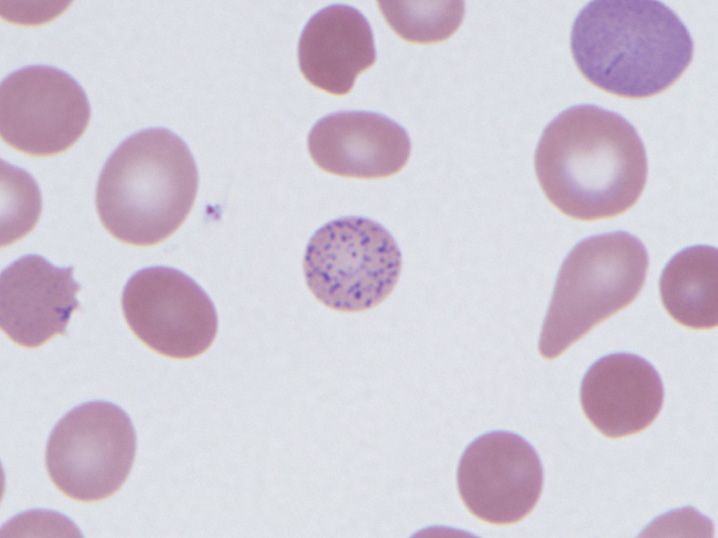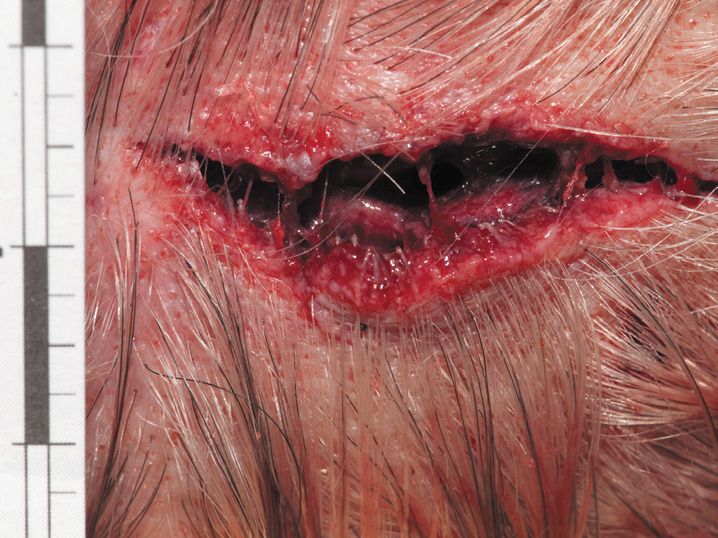FIGURE 2-1
(A) Acute carbon monoxide poisoning
(B) Alcohol intoxication
(C) Chronic carbon monoxide poisoning
(D) Flame inhalation with resulting pulmonary injury
(E) Oxygen deprivation
2. A 4-year-old child is anemic, and review of his blood smear demonstrates the following abnormality (see Figure 2-2). Which of the following is the most likely cause of his anemia?
(A) Acute lymphoblastic leukemia
(B) Aplastic anemia
(C) Hereditary spherocytosis
(D) Lead toxicity
(E) Sickle cell anemia
3. During a motor vehicle accident, a man sustains an injury that has the following appearance (see Figure 2-3); the tear in the skin demonstrates bridging strands of fibrous tissue. This type of injury is called a(n)
(A) Abrasion
(B) Contusion
(C) Incised wound
(D) Laceration
(E) Puncture wound
4. The leading cause of morbidity and premature death globally is
(A) Cardiovascular disease
(B) Genetic disorders
(C) Infectious disease
(D) Toxin exposure
(E) Undernutrition
5. One of the major components of smog is particulate matter, or “soot.” Particulate matter pollution is most harmful when it is what size?
(A) 10 μm or less
(B) 20–40 μm
(C) 50–100 μm
(D) 100–150 μm
(E) 150 (μ or larger
6. All of the following are true regarding lead poisoning except
(A) Gasoline is a major source of lead in the environment
(B) Children absorb a greater percentage of ingested lead than adults
(C) In adults, lead toxicity most commonly presents as a peripheral demyelinating neuropathy (wrist drop or foot drop)
(D) Most absorbed lead is incorporated into teeth and bone
(E) The maximum allowed lead blood level is 10 (μg/dL
7. The most preventable cause of human death is
(A) Asbestos exposure
(B) Cardiovascular disease
(C) Diphtheria
(D) Hepatitis
(E) Smoking
8. The effect of ionizing radiation on tissue is highly dependent on all of the following except
(A) Field size
(B) Tissue depth
(C) Tissue type being irradiated
(D) Total dose of radiation
(E) Type of radiation (x-rays, gamma rays, neutrons, etc.)
9. A child with malnutrition has severe wasting, loss of muscle mass, growth retardation, and a head that appears too large for his body. He has had little to eat of any type of food. This type of malnutrition is called
(A) Cachexia
(B) Kwashiorkor
(C) Marasmus
(D) Secondary malnutrition
(E) Wernicke–Korsakoff syndrome
10. Vitamin A is important in the function of all of the following except
(A) Bone mineralization
(B) Fatty acid metabolism
(C) Mucus-secreting epithelium
(D) Normal vision
(E) Resistance to some infections
11. A 6-year-old child from rural Greenland has immigrated with her parents. At her initial checkup, her legs appeared “bowed” and a chest x-ray is notable for excess cartilage at the costochondral junction of the ribs. She is most likely suffering from which of the following disorders?
(A) Achondroplasia
(B) Osteomalacia
(C) Osteoporosis
(D) Rickets
(E) Vitamin C deficiency
12. Leptin is a recently discovered regulatory protein involved in fat store regulation and obesity. Decreased leptin production in mice results in
(A) Anorexia
(B) Excessive overeating
(C) Excessive weight loss
(D) Increased heat production
(E) Increased physical activity
13. Several environmental factors and chemicals have been found to be highly associated with specific cancers. Which of the following pairs is incorrectly matched?
(A) Aflatoxin and hepatocellular carcinoma
(B) High fiber intake and colon cancer
(C) Nitrosamines and gastric cancer
(D) Polycyclic hydrocarbons and bladder cancer
(E) Vinyl chloride and hepatic angiosarcoma
14. All of the following are true regarding ethanol consumption except
(A) Acetaldehyde is the major metabolite of alcohol, and is responsible for many of the toxic effects
(B) Acute alcohol intoxication results in primarily CNS depressant effects
(C) Alcohol dehydrogenase is the major enzyme responsible for metabolizing alcohol
(D) Alcohol use results in more deaths than cocaine and heroin combined
Stay updated, free articles. Join our Telegram channel

Full access? Get Clinical Tree




